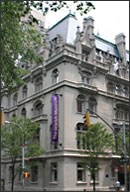The Museum Life

Once consisting of simple repositories of objects, museums today have become educational, cultural, and—some say—spiritual places of their own, pendant somewhere between houses of worship and spaces of entertainment and commerce. And Jewish museums?
The first Jewish museums arose in Western Europe and North America in the latter half of the 19th century, as modernized Jewish middle classes sought to preserve their receding rituals, folkways, and culture. In the U.S., beginning in the late 1960s, museum-building mounted in commemoration of the Holocaust and with the upsurge of interest in ethnicity and identity; more recently, American Jewish museums have become venues for bringing the fruits of scholarship to a wider audience in a setting livelier than the lecture hall. In Israel, museums have served additional functions: showcasing the crafts and arts of the new, developing society and the archeological remains of earlier Jewish presences, above all the Dead Sea Scrolls. The opening in 1978 of Tel Aviv's Beth Hatefutsoth, now named the Museum of the Jewish People and in the process of renewal, was a step in another direction, aiming to strengthen the new Jewish consciousness by, precisely, restoring its vital links with the past.
A recent issue of AJS Perspectives, a magazine of Jewish studies, gathers a number of essays exploring the dynamics of Jewish museums from multiple dimensions: how to present historical narratives that leave in place the open-endedness of history and the limited vision of historical actors; how to meet the challenges posed by the sheer destruction of so much Jewish material culture; how to strike a balance between the individual and collective experiences of museum visitors, as well as of the people whose stories are being told; how to cultivate an appreciation and love of Jewish history and life while avoiding stale ideologies and pious clichés; and so forth.
It is no accident that, in the U.S. and Europe, museums have become the most powerful vessel of Holocaust commemoration. They are suited to commemoration, and their aura is sufficiently sacral for the enormity of the subject, yet not so sacral as to stand or fall on the Shoah's impossible theological dilemmas. It may be this same mix of the sacral and the secular, of engagement and distance, of memory and expression, that makes museums so very suited to the temper of contemporary Jewish life at its own multiple crossroads.
Museums can become half-lit simulacra of lived experience or vital media of creativity and renewal. It all depends on what we do when we pass out of their doors and back into the light.
Comments are closed for this article.




